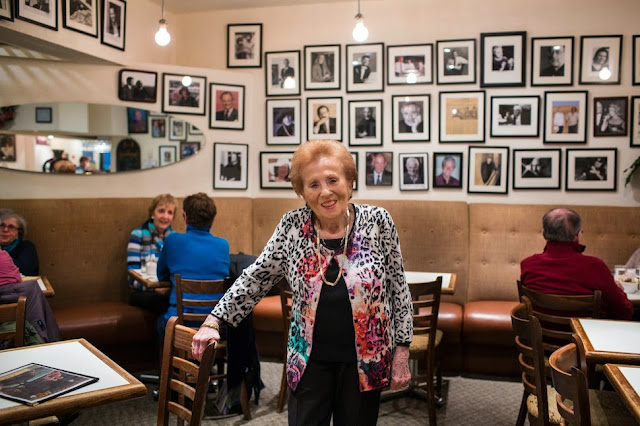Ruminations on Appetite for Words: Literary Dinner with Stratford Chefs School, Gastronomic Writer in Residence, Chef Andrew George Jr.
BY BRYAN LAVERY
DigiWriting Book
Marketing Agency (producers of the Stratford Writers Festival) launched Appetite for Words: A Literary Festival with
a Culinary Twist! at Stratford Chef School at end of October 2017, with Chef
Andrew George Jr. At the literary-themed dinners, food is paired with the
author’s readings, so participants can taste the words they’re hearing.
Canada 150 has been a year-long celebration of the
sesquicentennial of Canadian confederation. Fifty years ago the Canada Pavilion
at Expo 67, Canada’s centennial celebration in Montreal, contributed to
strengthening a powerful cultural unity. At the time the pavilion’s two
restaurants were seen as providing a national culinary narrative. Restaurant La
Toundra, operated by CN Hotels, served a Katimavik (which means “meeting place”
in the Inuktitut language) Special that included chilled Okanogan apple juice
and “Tourtière Chateau” with buttered peas and Saratoga chips. This was
followed by Coupe Innuit [sic].This conceptualization of a Canadian cuisine was
viewed as an all-encompassing initiative containing regional dishes and
traditions derived from the First Nations and other clichéd multiculturalism stereotypes
within the country. It seems to me the idea was to unite all recognizable cultures
practising their own culture within Canada.
Canadian cuisine really is an abstract concept, indefinable
due to the contradictory nature of Canadian identity. Indeed, ours is a complex
identity, and paradoxically includes vast cultural and culinary differences.
For many years serious attempts to define a national cuisine have either met
with derision or devolved into stereotypes.
If you were to ask most people about what is meant by
Canadian cuisine, many would respond with the stereotypical dishes like cod
tongues, prairie oysters, Nanaimo bars, poutine, tourtière, back bacon,
Montreal-smoked meat, butter tarts, seal flipper pie or fried bannock – a bread
introduced to First Nation communities by Scottish settlers. It would seem to
be unjust to identify one particular dish as being emblematic of Canadian
cuisine.
Co-Founder, Stratford Chefs School, Eleanor Kane said, “It
only seems right that chef Andrew George, Jr a member of the Wet’suwet’en First
Nations people be invited to be Stratford Chef School Gastronomic Writer in
Residence, during sesquicentennial year.” The program is one-of-a-kind and unique to chef
training in Canada. Launched in 2007, the program is sustained by the family of
the Joseph Hoare, former food editor at Toronto Life magazine, and a group of
other donors. The school's previous writers in residence have had wide-ranging
experiences in gastronomy, but have been mostly celebrated authors or
columnists. Chef is the co-author of Modern
Native Feasts: Healthy, Innovative,
Sustainable Cuisine; and A Feast
for all Seasons: Traditional Native Peoples’ Cuisine
At the Appetite for Words Literary Dinner at Stratford Chefs
School featuring Chef George, he spoke about giving instruction to both first
and second-year students ranging from cultural writing to recipe writing. Chef
also talked about his journey from the Bush (Wet’suwet’en traditional
territories and camps) to the World Culinary Olympics in Frankfurt.
The Wet’suwet’en
First Nations are semi-nomadic with two semi-permanent camps villages on the
Bulkley River and around Broman Lake and Francois Lake in the northwestern
Central Interior of British Columbia. Chef tells us, “The Wet’suwet’en First
Nations follow the cycle of the Salmon People”. Fishing for salmon is just as
an essential aspect of First Nation’s culture as eating it. It’s difficult to
measure the incredible bearing salmon has had on the Native people of British
Columbia. Salmon has been central to the First Nations diet, economy and
mythology for centuries.
Going back and looking
to tradition, Chef was required to do a lot of research to write his cookbook.
He spoke to us about translating
personal history into a cookbook. He
said he first he looked to his ancestors and his elders for guidance. There
weren’t any written recipes and cooking was based entirely on oral history.
Part of the difficulty and challenge was that it might take ten English words
to describe something fundamental to the Wet’suwet’en First Nations
culture.
A Feast for all Seasons: Traditional Native
People’s Cuisine is not only
broken into seasons but into elements of water, earth, land and air. There is
significance in fours, directions, seasons, elements and colours. The book pays homage to clan gatherings and
respect for the land. For everything that is taken from the land, there is
always something given back. When
First Nations communities think about the future, they’re not just considering
the next generation, they’re thinking about the following seven generations,
George explained. This long-term perspective makes them exceptionally competent
to cope with climate change and other environmental issues.
George has travelled the globe world to demonstrate and
promote the traditions and techniques of First Nations cuisine. He was part of
the first all-Aboriginal team at the World Culinary Olympics in Frankfurt,
Germany, in 1992. George was head chef at the Four Host First Nations pavilion
during the 2010 Winter Olympics in Vancouver. George was one of 25
international chefs to participate in an event called Culinary Diplomacy:
Promoting Cultural Understanding through Food, by invitation of Hillary Clinton
and organized by the US State Department in 2012.
The Appetite for Words Literary Dinner with Chef George
Jr.’s menu included Three Sisters Soup with Cornbread; a quartet of Smoked Fish
with Bannock Crisps, Braised Buffalo Ribs, Red Pepper Pesto, Baby Root
Vegetables and Wild Rice Pilaf. The dessert was Bannock and Berry Galette with
Crème Fraiche Ice Cream. Each course was expertly paired with a wine from Joie Farm.







Comments
Post a Comment